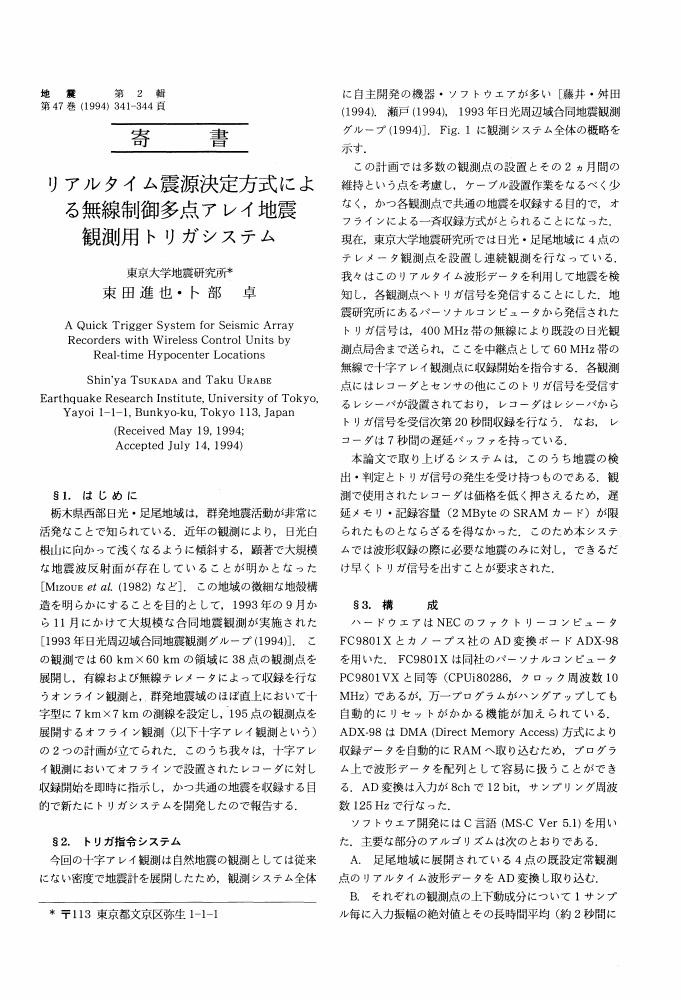7 0 0 0 OA P波エンベロープ形状を用いた早期地震諸元推定法
- 著者
- 束田 進也 小高 俊一 芦谷 公稔 大竹 和生 野坂 大輔
- 出版者
- 公益社団法人 日本地震学会
- 雑誌
- 地震 第2輯 (ISSN:00371114)
- 巻号頁・発行日
- vol.56, no.4, pp.351-361, 2004-03-25 (Released:2010-03-11)
- 参考文献数
- 18
- 被引用文献数
- 11 27
We have found that the envelope waveform of the initial part of P waves changes systematically with magnitude and epicentral distance. In order to represent the envelope waveform quantitatively we introduced a simple function of the form of Bt·exp(-At). Two parameters A and B can easily be determined by the least-squares method. The parameter B defines the slope of the initial part of the P-wave envelope and A is related to the amplitude growth or decay with time. When A is positive, B/(Ae) gives the maximum amplitude where e denotes the base of natural logarithm. This case is typical for small earthquakes, indicating that the initial amplitude increases sharply and decays quickly soon after the P-wave arrival. When A is negative, the amplitude increases exponentially with time. This is a characteristic of large earthquakes.We have found from the analysis of actual seismic data that log B is inversely proportional to the epicentral distance Δ even though the dispersion of data is somewhat large. This relation seems to be independent of earthquake magnitude and thus, by using this relation, we can roughly estimate the epicentral distance immediately after the P-wave arrival. Then, we can estimate the magnitude easily from the formula, similar to the conventional magnitude-amplitude relation, M=α·logVmax+β·logB+γ, where Vmax is the P-wave maximum amplitude within a given short time interval (e. g., 3 seconds) after the P-wave arrival. For M7- and M8-class earthquakes whose rupture duration reaches 10 sec or more, we need to estimate the magnitude repeatedly with time as the amplitude increases.The decrease of the parameter B with distance may be caused by anelasticity of the medium, scattering and geometrical spreading of P waves during propagation.
7 0 0 0 OA 地震学のアウトリーチにおける社会のニーズとノイズの研究
平成20年度に発生したチリ地震では津波の日本への到達が予測され,一日以上にわたって注意報や警報が発令された.地震発生から一週間後に津波に関する意識調査を実施した.「外国で起きた地震で発生した津波は日本まで到達することがあると思うか」などの問いに対しておよそ95%の正答率が得られ,日本人の津波に関するリテラシーの高さが明らかとなった.平成22年度はイタリアにおける地震予知問題に関する調査を実施した.地震予知情報を的確に発令しなかったことに対して,地震学者が刑事責任を問われるという特異な事件の経緯を現地調査も含めて詳しく分析した.
6 0 0 0 OA 稠密地震観測網記録による火球経路の決定
- 著者
- 石原 吉明 束田 進也 酒井 慎一 平松 良浩 古本 宗充
- 出版者
- 東京大学地震研究所
- 雑誌
- 東京大学地震研究所彙報 (ISSN:00408972)
- 巻号頁・発行日
- vol.76, no.1, pp.87-92, 2001-07-25
Fireballs, which are caused by high-velocity passages of meteorites through the atmosphere, generate shock waves. It has been known that such shock waves are often recorded on seismograms. It is possible to determine the trajectories and the sizes of a fireball using seismological records. We have searched shock wave signals from many bright fireballs observed in the period from September 1996 to November 1998, and the 1999 Kobe meteorite. The shock waves from one large fireball, which is called the Miyako fireball, and the Kobe meteorite are clearly recorded on many seismograms. In particular, the shock waves from the former fireball are widely recorded by the dense seismic array of 1997-98 joint seismic observations in the Tohoku Backbone Range. We determine their trajectories. Amplitudes of the shock waves are found to be possibly correlated with the masses of the meteorites. It is also indicated that the shock waves from fireballs, which are darker than brightness magnitude -10, are too weak to be recognized on the seismograms of ordinary seismic stations in Japan.
1 0 0 0 OA 地震情報の現状と課題
- 著者
- 束田 進也
- 出版者
- 公益社団法人 日本地震学会
- 雑誌
- 地震 第2輯 (ISSN:00371114)
- 巻号頁・発行日
- vol.61, no.Supplement, pp.575-589, 2009-07-31 (Released:2013-11-21)
- 参考文献数
- 46
Japan is a seismically active country, and earthquake information is indispensable in Japan. There are various systems or aspects concerning earthquake information, such as earthquake observations on scientific basis, real-time seismic data processing systems, dissemination systems of the results of processed data as earthquake information, and citizens’ understandings and utilization of the information. If the above mentioned whole flow can be called a “mechanism”, Japan is the only one that has the unique and advanced “mechanism” on earthquake information in the world. This mechanism, that can also be called one of the Japanese cultures, has not been built up in a reasonable way from the beginning but it took very long time in establishing the current mechanism. In addition, a new earthquake information provision service has been started that has the nature of earthquake forecast, not observation. Like this, the character of the mechanism has been changing. In this paper, the current Japanese earthquake information is outlined, and its issues are also described.
1 0 0 0 OA リアルタイム震源決定方式による無線制御多点アレイ地震観測用トリガシステム
- 著者
- 束田 進也 卜部 卓
- 出版者
- 公益社団法人 日本地震学会
- 雑誌
- 地震 第2輯 (ISSN:00371114)
- 巻号頁・発行日
- vol.47, no.3, pp.341-344, 1994-10-14 (Released:2010-03-11)
- 参考文献数
- 4
